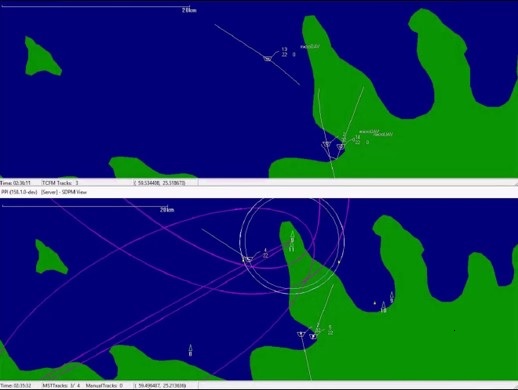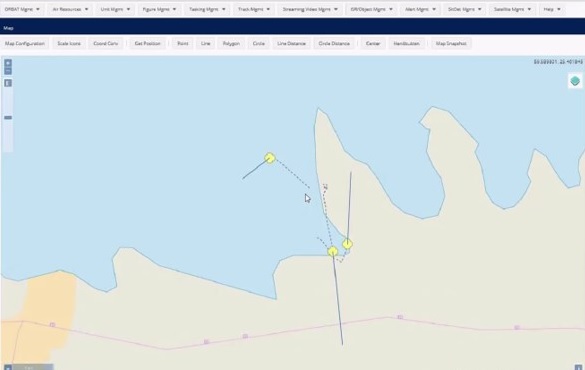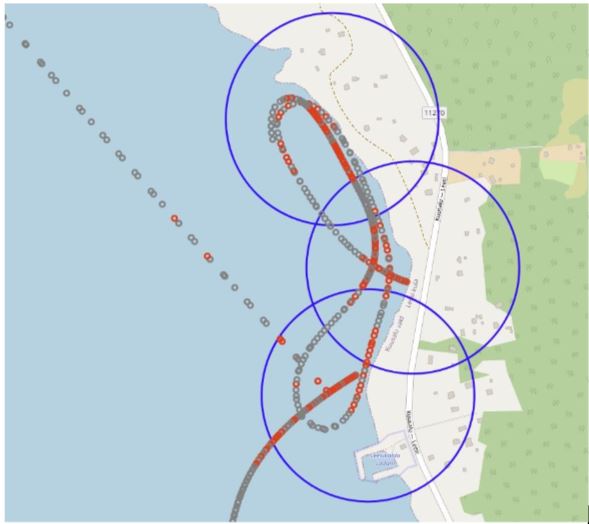The PADIC project partners conducted the PADIC System Simulator Tool Tests on September 11-13, 2023. PADIC partners performed tests from local offices in Estonia, Finland and Sweden, online, remotely, and internationally!
The objectives of the PADIC Simulator tests were:
Scope of the PADIC Simulator tests were:
The screenshots below provide an overview of the components that were tested in the week 37 remote tests.



Success experienced by PADIC partners:
During the AI-TC tests, we made sure that the AI-TC model outputs confidence levels for target classes from the trained model were performed well. The output of AI-TC can be displayed on the map as colors and/or labels. Red dots in the Figure indicate trajectories where the AI-TC has detected a hostile UAV.

On September 22, 2023, the results of the PADIC System Simulator Tool-I tests were presented for EST, FIN, SWE Mods and EC.
Project Coordinator Thomas Lindgren, Saab:
The simulation exercise during week 37 gave insight into the PADIC system strengths and weaknesses, as well as a first opportunity to test the system integration. Utilizing the system simulation tool, the group managed to plan sensor networks that provided better target tracking, than what was possible using only satellite imagery and coverage maps. The group was also successful in discovering problems with e.g., network disruption handling, providing the possibility to address these issues before field testing.
The PADIC Simulator tool will be a very useful tool for the PADIC team in the continuation of the PADIC project.
Tanel Järvet from CAFA Tech noted that the CAFA Tech team successfully tested the CAFA AI-Training Centre’s technology. Important feedback was received on how to further develop the AI-TC User Interface and Map modules.
Jari Kärkelä from Patria summarized that even though the focus of this test week was to test and demonstrate the PADIC System simulation capability, at the same time we already managed to test and verify many actual PADIC System key elements and functions, such as the sensor network solution, actual sensor interfaces, sensor data fusion and preliminary user interfaces. All of this from our local offices, online, remotely, and internationally!
The European Defence Industrial Development Program project “Passive Acquisition by Digital Convergence” (PADIC) will develop a coastal radar network system with an open architecture, connecting passive, digital sensors of different types. Passive radars use reflections from signals from TV and radio stations, mobile network base stations and added transmitters to detect objects on land, at sea and in the air. PADIC will study, design, prototype and test a coastal radar network system in response to emerging threats by further developing state-of-the-art sensors that are spectrally non-congesting during peacetime and sustainable and immune against attack attempts during conflicts. The project will make use of low-cost and commercially available technologies and components.
Views and opinions expressed are however those of the author(s) only and do not necessarily reflect those of the European Union or the European Commission. Neither the European Union nor the granting authority can be held responsible for them.

Views and opinions expressed are however those of the author(s) only and do not necessarily reflect those of the European Union or the European Commission. Neither the European Union nor the granting authority can be held responsible for them.
Grant Agreement No EDIDP-MSC-CPRS-2020-096-PADIC
| Cookie | Duration | Description |
|---|---|---|
| cookielawinfo-checkbox-analytics | 11 months | This cookie is set by GDPR Cookie Consent plugin. The cookie is used to store the user consent for the cookies in the category "Analytics". |
| cookielawinfo-checkbox-functional | 11 months | The cookie is set by GDPR cookie consent to record the user consent for the cookies in the category "Functional". |
| cookielawinfo-checkbox-necessary | 11 months | This cookie is set by GDPR Cookie Consent plugin. The cookies is used to store the user consent for the cookies in the category "Necessary". |
| cookielawinfo-checkbox-others | 11 months | This cookie is set by GDPR Cookie Consent plugin. The cookie is used to store the user consent for the cookies in the category "Other. |
| cookielawinfo-checkbox-performance | 11 months | This cookie is set by GDPR Cookie Consent plugin. The cookie is used to store the user consent for the cookies in the category "Performance". |
| viewed_cookie_policy | 11 months | The cookie is set by the GDPR Cookie Consent plugin and is used to store whether or not user has consented to the use of cookies. It does not store any personal data. |